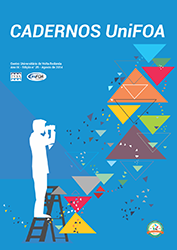Evaluation of marginal infiltration by varying the adhesive protocol
in vitro study
DOI:
https://doi.org/10.47385/cadunifoa.v20.n55.5530Palabras clave:
Composite Resins, Dental Leakage, DentinResumen
Aim: The aim of this study was to evaluate the sealing of composite resin restorations, observing marginal infiltration through a conventional resin by varying the adhesive technique. Materials and Methods: Cavity preparations were performed on the buccal and lingual surfaces with margins at the cement-enamel junction. The samples were divided into three groups (n=10): Group 1-Selective conditioning technique; Group 2-Total conditioning technique; Group 3-Non conditioning. After, the restorations were made using conventional composite resin, immersed in methylene blue (C16H18ClN3S) for seven days and evaluated in a standardized manner, through scores, and analyzed the penetration depth of the dye. Results: The data were submitted to the Tukey test with a significance level of 5%. The results showed that the samples that were not conditioned obtained the highest infiltration rates (p=0.0001). Discussion: The integrity of the margins of a restoration is essential to clinical success, since its absence is directly related to the emergence of interface infiltrations. Conclusion: The authors concluded that the worst group was the one without etching; enamel showed less infiltration than dentin for all groups; the technique of selective etching and total etching obtained similar results regarding microleakage.
Descargas
Citas
Abad-Coronel, Cristian; Naranjo, Belén; Valdiviezo, Pamela. Adhesive Systems Used in Indirect Restorations Cementation: Review of the Literature. Dentistry journal, v. 7, n. 3, 1 Jul. 2019. DOI: https://doi.org/10.3390/dj7030071
Anusavice, K.J. Phillips materiais dentários. 11.ed ed. [S.l.]: Elsevier, 2005.
Bail, M. et al. Effect of air-drying on the solvent evaporation, degree of conversion and water sorption/solubility of dental adhesive models. Journal of Materials Science: Materials in Medicine, v. 23, n. 3, p. 629–638, 31 Mar. 2012. DOI: https://doi.org/10.1007/s10856-011-4541-y
Buonocore, Michael G. A Simple Method of Increasing the Adhesion of Acrylic Filling Materials to Enamel Surfaces. Journal of Dental Research, v. 34, n. 6, p. 849–853, 9 Dec. 1955. DOI: https://doi.org/10.1177/00220345550340060801
Carvalho, Ricardo M. et al. A challenge to the conventional wisdom that simultaneous etching and resin infiltration always occurs in self-etch adhesives. Biomaterials, v. 26, n. 9, p. 1035–1042, Mar. 2005. DOI: https://doi.org/10.1016/j.biomaterials.2004.04.003
Chiba, A. et al. The effects of ethanol on the size-exclusion characteristics of type I dentin collagen to adhesive resin monomers. Acta Biomaterialia, v. 33, p. 235–241, Mar. 2016. DOI: https://doi.org/10.1016/j.actbio.2016.01.040
Fujiwara, Satoshi et al. Effect of double-layer application on bond quality of adhesive systems. Journal of the mechanical behavior of biomedical materials, v. 77, p. 501–509, Jan. 2018. DOI: https://doi.org/10.1016/j.jmbbm.2017.10.008
Hashimoto, Masanori et al. Resin-enamel bonds made with self-etching primers on ground enamel. European Journal of Oral Sciences, v. 111, n. 5, p. 447–453, Oct. 2003. DOI: https://doi.org/10.1034/j.1600-0722.2003.00060.x
Li, Bingqing et al. Selective demineralisation of dentine extrafibrillar minerals—A potential method to eliminate water-wet bonding in the etch-and-rinse technique. Journal of Dentistry, v. 52, p. 55–62, Sep. 2016. DOI: https://doi.org/10.1016/j.jdent.2016.07.008
Maravic, Tatjana et al. How Stable is Dentin As a Substrate for Bonding? Current Oral Health Reports, v. 4, n. 3, p. 248–257, 7 Sep. 2017. DOI: https://doi.org/10.1007/s40496-017-0149-8
Muñoz, Miguel Angel et al. Immediate bonding properties of universal adhesives to dentine. Journal of Dentistry, v. 41, n. 5, p. 404–411, May. 2013. DOI: https://doi.org/10.1016/j.jdent.2013.03.001
Nakabayashi, Nobuo; Kojima, Katsunori; Masuhara, Eiichi. The promotion of adhesion by the infiltration of monomers into tooth substrates. Journal of Biomedical Materials Research, v. 16, n. 3, p. 265–273, May. 1982. DOI: https://doi.org/10.1002/jbm.820160307
Perdigão, Jorge. Current perspectives on dental adhesion: (1) Dentin adhesion - not there yet. The Japanese dental science review, v. 56, n. 1, p. 190–207, Nov. 2020. DOI: https://doi.org/10.1016/j.jdsr.2020.08.004
Swift, E J; Perdigão, J; Heymann, H O. Bonding to enamel and dentin: a brief history and state of the art, 1995. Quintessence international (Berlin, Germany: 1985), v. 26, n. 2, p. 95–110, Feb. 1995.
Van Meerbeek, B. et al. The clinical performance of adhesives. Journal of Dentistry, v. 26, n. 1, p. 1–20, Jan. 1998. DOI: https://doi.org/10.1016/S0300-5712(96)00070-X
Vermelho, Paulo Moreira et al. Adhesion of multimode adhesives to enamel and dentin after one year of water storage. Clinical oral investigations, v. 21, n. 5, p. 1707–1715, Jun. 2017. DOI: https://doi.org/10.1007/s00784-016-1966-1
Descargas
Publicado
Cómo citar
Número
Sección
Licencia
Derechos de autor 2025 Cadernos UniFOA

Esta obra está bajo una licencia internacional Creative Commons Atribución-NoComercial-CompartirIgual 4.0.
Declaração de Transferência de Direitos Autorais - Cadernos UniFOA como autor(es) do artigo abaixo intitulado, declaro(amos) que em caso de aceitação do artigo por parte da Revista Cadernos UniFOA, concordo(amos) que os direitos autorais e ele referentes se tornarão propriedade exclusiva desta revista, vedada qualquer produção, total ou parcial, em qualquer outra parte ou meio de divulgação, impressa ou eletrônica, sem que a prévia e necessária autorização seja solicitada e, se obtida, farei(emos) constar o agradecimento à Revista Cadernos UniFOA, e os créditos correspondentes. Declaro(emos) também que este artigo é original na sua forma e conteúdo, não tendo sido publicado em outro periódico, completo ou em parte, e certifico(amos) que não se encontra sob análise em qualquer outro veículo de comunicação científica.
O AUTOR desde já está ciente e de acordo que:
- A obra não poderá ser comercializada e sua contribuição não gerará ônus para a FOA/UniFOA;
- A obra será disponibilizada em formato digital no sítio eletrônico do UniFOA para pesquisas e downloads de forma gratuita;
- Todo o conteúdo é de total responsabilidade dos autores na sua forma e originalidade;
- Todas as imagens utilizadas (fotos, ilustrações, vetores e etc.) devem possuir autorização para uso;
- Que a obra não se encontra sob a análise em qualquer outro veículo de comunicação científica, caso contrário o Autor deverá justificar a submissão à Editora da FOA, que analisará o pedido, podendo ser autorizado ou não.
O AUTOR está ciente e de acordo que tem por obrigação solicitar a autorização expressa dos coautores da obra/artigo, bem como dos professores orientadores antes da submissão do mesmo, se obrigando inclusive a mencioná-los no corpo da obra, sob pena de responder exclusivamente pelos danos causados.










